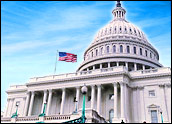
As part of an overhaul of its public-facing front-door website, USA.gov, the U.S. federal government has released the first in a long list of planned mobile phone applications for citizens. Some have downloadable modules optimized for specific mobile phone platforms; others come in the form of websites optimized for access through Web browsers running on mobile devices.
Less than a week after their release, though, the mobile apps already are receiving raised eyebrows due to a perceived leaning toward the iPhone platform. Of the 18 mobile tools available as of this writing, six are available only on the iPhone platform in addition to having a generic, mobile Web offerings. This set includes the NASA app, which allows access to popular image data from space missions, and the U.S. Postal Service app. Two apps are offered in the Android platform: Product Recalls and UV Index. Only the UV Index app is offered on the BlackBerry OS. The remaining ten applications are available through the mobile Web only.
Playing Favorites?
Although the promotional material from the federal government, including Twitter and blog posts, states that apps are planned for a variety of “popular” mobile phone operating systems, one must wonder why a full one-third of the first flight of apps is available only for the iPhone, and the BlackBerry sports a measly, single app.
“The government likely focused on the platform with the most hyped application platform,” according to Alex Spektor, analyst with Strategy Analytics. “It is also helpful that Apple’s platform is easy to develop for, provides access to a strong touchscreen user experience, and has a robust distribution platform –3 the iTunes App Store,” Spektor told TechNewsWorld.
However, the iPhone likely won’t appear to be the only darling of the feds for long, predicted Spektor. The BlackBerry has an installed base in the U.S. about twice as large as iPhone’s, he pointed out, although that group boasts a large proportion of corporate users, who arguably also have netbooks or laptops with which to access the Web while on the go. In addition, though, Android is growing fast, he pointed out. “We forecast the installed base of Android users in the U.S. to surpass that of Apple by next year,” Spektor said.
Luck of the Draw?
The selection of apps available doesn’t reflect a preference for the iPhone as much as an attempt to reach the largest audience possible, Greg Sterling, founder and principal with Sterling Market Intelligence told TechNewsWorld. In fact, the majority of the mobile tools are available on the mobile Web only. This group includes those that arguably have the most urgent utility right now for the biggest groups of interested citizens.
For example, the Find Your Embassy tool, which allows travelers to “search, find and contact the nearest U.S. Embassy anywhere in the world,” is a Web-only application. So is the disaster-recovery tool called u201cFEMA Mobile,u201d as are the Veterans Affairs Mobile tool and the National Institute of Health’s Medline Plus. Other mobile-Web-only sites include the Alternative Fuel locator, which allows drivers to find the five closest biodiesel, electricity, ethanol, hydrogen, natural gas and propane fueling sites.
The tools vary widely in functionality from providing just text-based information to offering specialized features. The Product Recalls app, for instance, allows users to scan the barcode of any product to see if it appears on any of a wide range of recall lists. The U.S. Postal Service Tools app provides access to the Post Office’s package tracking database.





















































